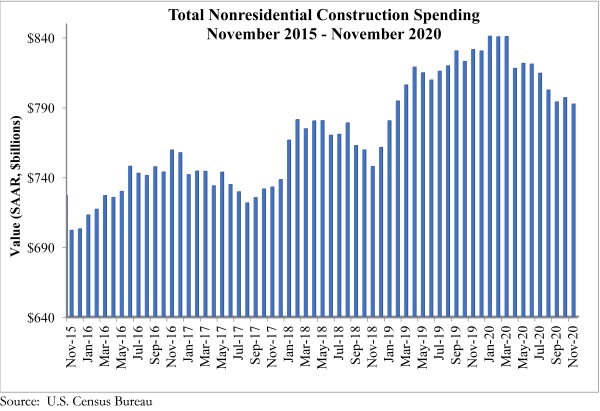Nonresidential Construction Spending Declines in November, Says ABC
WASHINGTON, Jan. 4—National nonresidential construction spending fell 0.6% in November 2020, according to an Associated Builders and Contractors analysis of data published today by the U.S. Census Bureau. On a seasonally adjusted annualized basis, spending totaled $792.5 billion for the month.
Ten of the sixteen nonresidential subcategories saw decreased spending on a monthly basis. Private nonresidential spending fell 0.8%, while public nonresidential spending fell 0.2% in November.
“Typically, spending patterns in nonresidential construction lag behind those of the overall economy by 12 to 18 months,” said ABC Chief Economist Anirban Basu. “But the pandemic-induced downturn of 2020 was so abrupt and created such massive issues for developers, state and local governments, and others who purchase construction services that the impact on nonresidential construction was virtually immediate. As a result, private nonresidential construction spending is down 9.5% since November 2019.
“The single hardest hit segment of the industry is lodging, a category in which construction spending declined more than 8% in a single month and 27% since the same time last year,” said Basu. “While leisure travel is likely to rebound as more Americans are vaccinated, business travel may take years to recover. This bodes poorly for the construction of hotels with elaborate meeting spaces located in central business districts or close to airports.
“The near-term nonresidential construction spending outlook is generally not positive,” said Basu. “While there will be certain construction segments that remain active, including data centers, fulfillment centers and certain healthcare facilities, commercial construction is positioned to be weak for the next several quarters. This is reflected in ABC’s Construction Backlog Indicator, which in November reached its lowest level since the beginning of 2011.
“Many public segments have also experienced declines in spending in recent months,” said Basu. “The good news is that public construction may receive a substantial boost from post-inauguration stimulus. Infrastructure investment often produces additional opportunities for profitable private development. Suburban commercial developers may also take heart in America’s ongoing residential construction boom, with residential construction spending up more than 16% on a year-over-year basis, as interest in homeownership surges.”

